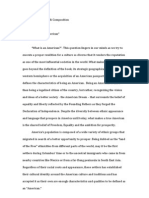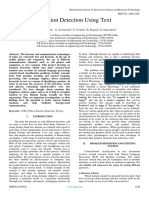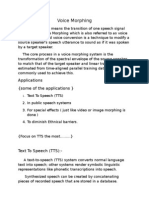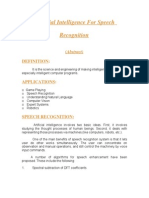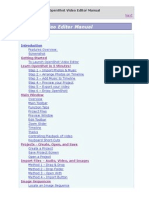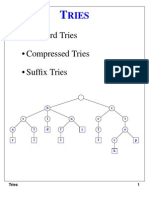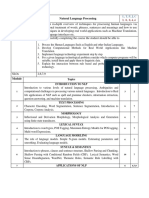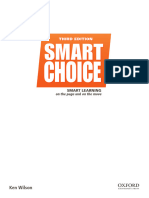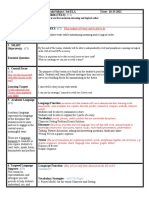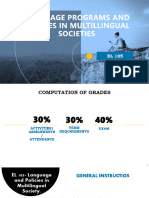Professional Documents
Culture Documents
Bidirectional Dictionary Based Machine
Copyright
Available Formats
Share this document
Did you find this document useful?
Is this content inappropriate?
Report this DocumentCopyright:
Available Formats
Bidirectional Dictionary Based Machine
Copyright:
Available Formats
Volume 5, Issue 4, April – 2020 International Journal of Innovative Science and Research Technology
ISSN No:-2456-2165
Bidirectional Dictionary Based Machine
Translation for Wolaytegna-Amharic by Java
Temesgen Mengistu Helana
Department of Computer Science
School of Informatics
Wolaita Sodo University, WSU
Wolaita Sodo, Ethiopia
Abstract:- In this paper, Wolaytegna to Amharic In this research work the Bilingual dictionary which is
machine translation were conducted using dictionary used in the Wolaytegna to Amharic translation and vice
based machine translation approach. Machine versa is the core components of a machine translation of
translation system one of a key purpose Natural these two languages. There are many approaches for
Language processing and it is a process of translating developing the MT systems, each approach has their own
from one language to another. In this study the advantages and disadvantages. Out of these approaches
researcher were translated two Ethiopian languages one dictionary based machine translation the most
local language (Wolaytegna) and the other one is official recommended for linguistically less resourced language
language of the country (Amharic) by using dictionary like Wolaytegna. In Ethiopia there are about 80 different
based approach. This research is very important for the languages are available from which Wolaytegna is the 7th
development of the Wolaytegna language which is most spoken language which is spoken by around 7 million
spoken by around 7 million people in Wolaytta zone and people in the country specially by Wolaytta people in
other part of the Ethiopia. For this research we used SNNPR and one of a language with few resource published
Java, MYSQL database and 5400 word entries in electronically in internet and other different media.
dictionary were created in the database to create Oppositely Amharic is historically advantageous language
accurate translation. For all words of source language in Ethiopia because different regime at different period in
we defined meaning in target language in bilingual Ethiopia used the language as official language of the
dictionary. The proposed methodology uses dictionary country so that it is one of linguistically well resourced
for translating word by word without much because this languages compared to other Ethiopian languages.
kind of approach is very advisable for linguistically less
resourced language like Wolaytegna. So this research work will supports Amharic speakers
to use Wolaytegna and Vice-versa by using dictionary
Keyword:- Wolaytegna, Machine translation, Dictionary, based machine translation.
Bilingual, Multilingual, Natural language processing.
The biggest challenge for Statistical Machine
I. INTRODUCTION Translation is to get the high quality corpus because of
insufficient sources of the data for the language like
Translation systems plays a vital role in narrowing the Wolaytegna. Dictionary Based Machine Translation
communication barrier between human race from different (DBMT) approach is used when less number of linguistic
corner of the world. Natural Language Processing (NLP) is resources is available for the languages. In the dictionary
a core discipline in machine translation and it is field of based translation, a system is defined which contains set of
computer science devoted to the improvement of models source language word and corresponding target language
and technologies empowering computers to use human words. During the run time, dictionary based translation use
languages both as input and output [3]. One of the aim of bilingual corpus as its database which is defined in the form
NLP is to develop computational models that can have of dictionary. This database is stored in the translation
equal performance like in the task of reading, writing, memory. Since the two languages, Wolaytegna and
learning, speaking and understanding. Computational Amharic have the same grammatical sentence structure, so
models are useful to explore the nature of linguistic that when the system encounters the any sentence the
communication as well as for enabling effective human- system does not require any rearrange in the sentence
machine interaction. rather it translates directly by retrieving from the translation
memory.
This speedy growth of data on internet was
encouragement for the MT researchers to develop more
profitable MT systems to deliver a worldwide
communication.
IJISRT20APR095 www.ijisrt.com 1344
Volume 5, Issue 4, April – 2020 International Journal of Innovative Science and Research Technology
ISSN No:-2456-2165
II. CHALLENGES IN DICTIONARY BASED III. PROPOSED SYSTEM MODEL
MACHINE TRANSLATION SYSTEM
Most of the Wolaytegna to Amharic translation looks
In this research some of few challenge while similar to the following sample example described below.
translating Wolaytegna to Amharic are in Wolaytegna some The sentence formation [Subject, Object , Verb] is similar in
words have same spelling and pronunciation but different both languages.
meaning based on sentence context. So that the dictionary Example: => Temesgen went to school.
based machine translation translates one language to the
other by using word based dictionary stored in database.
Amharic language has no proposition and it takes both
prefix and postfix but Wolaytegna takes only postfix. This
difference made to two language translation challenging
because form one root Wolaytegna word we may numerous
words with postfix which are may or may not from same
Amharic word. The following example illustrates sample Fig 1:- The diagram illustrates grammatically how the two
words: language translation works
Example: As described in the above diagram translation cannot
Naaga - ተተተ - wait (he) have Fig happen similarly for all Wolaytegna sentence to
Naagu- ተተተ wait (she) Amharic because while we are working with tense, gender,
Naagikke- ተተተተተተ don’t wait (he) pronounce and other aspects in special case sometimes the
Naagiis- ተተተተ waited sentence reverses and words may be reshuffled. Within this
Naago ተተተተ let him to wait translation system we considered all these aspects.
Naagoo- ተተተተተ can I wait? …… (he)
Fig 2:- Framework of dictionary based machine translation of Wolaytegna to Amharic
We will explain basic details of those steps in C. Detecting contextual ambiguity from alternatives
architectural model in the following content. A word may have more than one meaning in different
sentence with same spelling and pronunciation.
A. Splitting sentence into words
In this research translation can be word based, phrase D. Retrieving target word
based or sentence based; so that if the input is phrase or In this stage of machine translation checking for the
sentence it must be break into words because the entry in availability of each words of source language in given
database is only word based in dictionary. sentence and storing to defined array.
B. Identifying tense, gender, plurality E. Reconstructing sentence in target language
Since both language uses prefix and postfix to identify After extracting equivalent meaning from dictionary
tense, gender and plurality basically it is better to detect the for each words in source text reconstructing process takes
root word and prefix and postfix attached to the word. In place.
this research work we faced challenge with considering the
three key morphological contents.
IJISRT20APR095 www.ijisrt.com 1345
Volume 5, Issue 4, April – 2020 International Journal of Innovative Science and Research Technology
ISSN No:-2456-2165
IV. THE ALGORITHM Step 4: for word in words
If Check in database
A. Pseudo code Retrieve matching meaning value
Step1 : Start target_text value
Else Break, not found in db
Step2 : read source text Step 5: display target_text
Step 6: End
Step 3: split source_text into word
B. Flowchart
The following flowchart elucidates how the machine
translation algorithm works. In this case we considered if
the input text is a single word or a sentence it can translates
the input into the target text using dictionary database.
Fig 3:- Dictionary based machine translation algorithm of Wolaytegna to Amharic
V. EXPERMENTAL RESULTS
In the following section some of the screenshot
outputs of the experimental reports and the sample codes
related with bidirectional dictionary based machine
translation system were illustrated.
Fig 5:- Retrieving the MT entry from the dictionary
Fig 4:- Inserting created text dictionary into database
IJISRT20APR095 www.ijisrt.com 1346
Volume 5, Issue 4, April – 2020 International Journal of Innovative Science and Research Technology
ISSN No:-2456-2165
Fig 6:- Store entries for dictionary in wamp database.
Fig 7:- The main interface before feeding texts of source language.
IJISRT20APR095 www.ijisrt.com 1347
Volume 5, Issue 4, April – 2020 International Journal of Innovative Science and Research Technology
ISSN No:-2456-2165
Fig 8:- The figure illustrated how bilingual machine translator works
VI. CONCLUSION [6]. Tariku Tsegaye, “ENGLISH -TIGRIGNA
FACTORED STATISTICAL MACHINE
Machine Translation plays a vital role in breaking the TRANSLATION” 2014
language barrier and promoting the Interlingua [7]. S. Kereto, C. Wongchaisuwat, Y. Poovarawan,
communication in a multilingual country like Ethiopia. In “Machine translation research and development´. In
this paper, dictionary based machine translation approach is proceedings of the Symposium on Natural Language
used for developing the MT system for Wolaytegna and processing in Thailand, pages 167-195, March 1993.
Amharic. The dictionary based approach is well suited for [8]. K. Narayana Murthy “A Machine Assisted Translation
the languages which have the minimal linguistic resources System” ,Department of Computer and Information
and for the languages with the similar structure. For Sciences, University of Hyderabad, Hyderabad,
dictionary based approach bilingual dictionary is the crucial INDIA.
resource. Here bilingual dictionary with 4500 entries is [9]. Murthy. K,“MAT: A Machine Assisted Translation
developed and stored in Mysql and the user interface were system”, In Proceedings of Symposium on Translation
designed with java. The postfix and prefix of Amharic Support System( STRANS-2002), IIT Kanpur.2002,
language words are translated to Wolaytegna language pp. 134-139.
word with only postfix by machine translation algorithm. [10]. Balajapally, P., Bandaru, P., Ganapathiraju, M.,
Dictionary based approach can be further improved by Balakrishnan, N., & Reddy, R. (2006).
adding more corpus and contextualize grammatical Multilingual Book Reader: Transliteration, Word-to-
translation for both the languages. Words with multiple Word Translation and Full-text Translation. In VAVA
meaning were challenge in Bilingual dictionary based 2006.
machine translation in Wolaytegna to Amharic. [11]. Jingying Zhao, Hai Guo, Zhenhong Zheng, Nan Jiang,
“The Implemention of Chinese-Tai Lue Electronic
REFERENCES Dictionray Based on C#”, Department of Computer
Science and Engineering University of Dalian
[1]. D V Sindhu and B M Sagar 2017 IOP Conf. Ser.: Nationalities CHINA, 2010
Mater. Sci. Eng. 225 012182
[2]. W.John Hutchins and Halord L. Somers, “An
Introduction To Machine Translation”, Academic
Press Ltd.,1992, pp 1-9.
[3]. Daniel Jurafsky and James H. Martin, Speech and
Language Processing, Pearson Education Inc, 2005.
[4]. Remya Rajan , , “Rule Based Machine Translation
from English to Malayalam” .2009
[5]. K. Narayana Murthy “A Machine Assisted Translation
System” ,Department of
Computer and Information Sciences, University of
Hyderabad, Hyderabad, INDIA.
IJISRT20APR095 www.ijisrt.com 1348
You might also like
- 10EC65 Operating Systems - Structure of Operating SystemsDocument37 pages10EC65 Operating Systems - Structure of Operating SystemsShrishail BhatNo ratings yet
- IELTS Writing VocabularyDocument20 pagesIELTS Writing VocabularyYorlen NuñezNo ratings yet
- Artificial Intelligence and Expert SystemsDocument10 pagesArtificial Intelligence and Expert SystemsManish Kumar KashyapNo ratings yet
- Mini Project I: Literature SearchDocument5 pagesMini Project I: Literature SearchFernando GalindoNo ratings yet
- 104 Course GuideDocument11 pages104 Course GuideRitz Danica Blanza100% (2)
- Introduction To Programming LanguageDocument13 pagesIntroduction To Programming LanguageDr Narayana Swamy Ramaiah100% (1)
- American Definition EssayDocument2 pagesAmerican Definition EssayDenise Nicole100% (1)
- Digital Signal Processing (DSP)Document5 pagesDigital Signal Processing (DSP)abdullahNo ratings yet
- NLP QBDocument14 pagesNLP QBIshika Patel100% (1)
- 64 Natural Language Processing Interview Questions and Answers-18 Juli 2019Document30 pages64 Natural Language Processing Interview Questions and Answers-18 Juli 2019Ama AprilNo ratings yet
- If I Were A Boy - BeyoncéDocument4 pagesIf I Were A Boy - BeyoncéSantiago MoralesNo ratings yet
- B - N - M - Institute of Technology: Department of Computer Science & EngineeringDocument44 pagesB - N - M - Institute of Technology: Department of Computer Science & Engineering1DT18IS029 DILIPNo ratings yet
- If I Were A BoyDocument1 pageIf I Were A BoyErnesto MirandaNo ratings yet
- Oxford Heroes Test Book 1 PDFDocument30 pagesOxford Heroes Test Book 1 PDFEugenia MenchónNo ratings yet
- Natural Language ProcessingDocument5 pagesNatural Language ProcessingSherry SherNo ratings yet
- Interchange 2 - Rquiz Units 3 & 4 - Revisión Del IntentoDocument4 pagesInterchange 2 - Rquiz Units 3 & 4 - Revisión Del IntentoPAULA MURILLO100% (1)
- Tibet. Volume Two: Assimilation Into Indigenous Scholarship (HandbuchDocument5 pagesTibet. Volume Two: Assimilation Into Indigenous Scholarship (Handbuchyogeshwithraj505No ratings yet
- Table of ContentDocument13 pagesTable of Contentrekha_rckstarNo ratings yet
- Fil 251 Semester Test Quarter 2Document5 pagesFil 251 Semester Test Quarter 2monica vrNo ratings yet
- Developing an Amharic Text-to-Speech System Using Cepstral MethodDocument7 pagesDeveloping an Amharic Text-to-Speech System Using Cepstral MethodEndalew SimieNo ratings yet
- VoiceToSign Proposal FinalDocument22 pagesVoiceToSign Proposal FinalhabibNo ratings yet
- Emotion Detection From TextDocument12 pagesEmotion Detection From TextIJERDNo ratings yet
- NLP Cook BOOK With TransformersDocument27 pagesNLP Cook BOOK With TransformersasdfghjkNo ratings yet
- Difference Between Compiled and Interpreted Programming LanguagesDocument1 pageDifference Between Compiled and Interpreted Programming LanguagesM.ILYASNo ratings yet
- NLP ReportDocument23 pagesNLP ReportAnonymous TVE0T8rNo ratings yet
- 04 - 05-AI-Knowledge and ReasoningDocument61 pages04 - 05-AI-Knowledge and ReasoningderbewNo ratings yet
- Langauage ModelDocument148 pagesLangauage ModelsharadacgNo ratings yet
- Software Requirement Specification DocumentDocument9 pagesSoftware Requirement Specification DocumentKuldeep Singh100% (1)
- Speech Recognition PresentationDocument36 pagesSpeech Recognition PresentationPrafull Agrawal100% (1)
- Speech Recognition System - A ReviewDocument10 pagesSpeech Recognition System - A ReviewAkmad Ali AbdulNo ratings yet
- Emotion Detection Using TextDocument5 pagesEmotion Detection Using TextInternational Journal of Innovative Science and Research TechnologyNo ratings yet
- Phonetic TypewriterDocument14 pagesPhonetic Typewritermisharavi337No ratings yet
- Mariawit Shimelis 2020Document130 pagesMariawit Shimelis 2020hayu B.No ratings yet
- Automatic Speech RecognitionDocument45 pagesAutomatic Speech RecognitionrahulNo ratings yet
- Pattern Based Indonesian Question Answering SystemDocument6 pagesPattern Based Indonesian Question Answering SystemEri ZuliarsoNo ratings yet
- Speech Recognition Full ReportDocument11 pagesSpeech Recognition Full ReportpallavtyagiNo ratings yet
- Internet and The World Wide WebDocument3 pagesInternet and The World Wide WebAdrian BagayanNo ratings yet
- Ethiopian Sign Language Conversion SystemDocument86 pagesEthiopian Sign Language Conversion SystemAmanuel KassaNo ratings yet
- CSCI 4152/6509 Natural Language Processing: Lab 1: FCS Computing Environment, SVN TutorialDocument38 pagesCSCI 4152/6509 Natural Language Processing: Lab 1: FCS Computing Environment, SVN TutorialBrakadeesh ShankarNo ratings yet
- Facial Recognition Using Eigen FacesDocument3 pagesFacial Recognition Using Eigen FacesAkshay ShindeNo ratings yet
- Unit 3 NormalizationDocument157 pagesUnit 3 NormalizationSourav mukhopadhyayNo ratings yet
- Voice MorphingDocument5 pagesVoice MorphingNaveen Krishnan100% (4)
- Brain SyncDocument3 pagesBrain Syncjbone918No ratings yet
- Tamil Morphological AnalysisDocument18 pagesTamil Morphological AnalysisKarthik SankarNo ratings yet
- Software Requirements Specification: COMSATS University Islamabad, COMSATS Road, Off GT Road, Sahiwal, PakistanDocument13 pagesSoftware Requirements Specification: COMSATS University Islamabad, COMSATS Road, Off GT Road, Sahiwal, PakistanFarah QandeelNo ratings yet
- Lec Notes For Pervasive ComputingDocument9 pagesLec Notes For Pervasive ComputingangurajuNo ratings yet
- Artificial Intelligence For Speech RecognitionDocument9 pagesArtificial Intelligence For Speech RecognitionNeha BhoyarNo ratings yet
- Review On Natural Language ProcessingDocument4 pagesReview On Natural Language ProcessingzemikeNo ratings yet
- Modeling Data ObjectDocument36 pagesModeling Data ObjectAsib KassayeNo ratings yet
- Image Captioning using Deep LearningDocument5 pagesImage Captioning using Deep LearningRaunak JalanNo ratings yet
- Sign Language To Voice ConverterDocument13 pagesSign Language To Voice ConverterAnoop K VenuNo ratings yet
- Speech Recognition Using Ic HM2007Document31 pagesSpeech Recognition Using Ic HM2007Nitin Rawat100% (4)
- Stock Prediction Using Web Sentiments, Financial News and QuotesDocument5 pagesStock Prediction Using Web Sentiments, Financial News and QuotesJournal of ComputingNo ratings yet
- Approaches For Knowledge RepresentationDocument14 pagesApproaches For Knowledge RepresentationSimon WojaNo ratings yet
- Lecture NLPDocument38 pagesLecture NLPharpritsingh100% (1)
- Ai in Speech RecognitionDocument24 pagesAi in Speech RecognitionhimanshuNo ratings yet
- Spell Correction for Azerbaijani Using Deep Neural NetworksDocument5 pagesSpell Correction for Azerbaijani Using Deep Neural NetworksAnmol SinhaNo ratings yet
- Book AnswersDocument43 pagesBook AnswersOmar NegmNo ratings yet
- Application of Fsa To NLPDocument21 pagesApplication of Fsa To NLPAnimesh ShawNo ratings yet
- OpenShot ManualDocument68 pagesOpenShot Manualbugnonchristine0% (1)
- Software Requirements Specification - Sign Language To TextDocument19 pagesSoftware Requirements Specification - Sign Language To TextAman BindNo ratings yet
- Ch11 3 TriesDocument11 pagesCh11 3 TriesAatika FatimaNo ratings yet
- HCI-unit 2Document32 pagesHCI-unit 2testUSerBotNo ratings yet
- CSE4022 Natural-Language-Processing ETH 1 AC41Document6 pagesCSE4022 Natural-Language-Processing ETH 1 AC41Arkadeepta RoyNo ratings yet
- Frontiers of AI: An Introduction to Key AreasDocument19 pagesFrontiers of AI: An Introduction to Key Areasjillian llanesNo ratings yet
- Spoken Language Parsing Using Phrase-Level Grammars and Trainable ClassifiersDocument8 pagesSpoken Language Parsing Using Phrase-Level Grammars and Trainable ClassifiersnombreNo ratings yet
- Comparatively Design and Analyze Elevated Rectangular Water Reservoir with and without Bracing for Different Stagging HeightDocument4 pagesComparatively Design and Analyze Elevated Rectangular Water Reservoir with and without Bracing for Different Stagging HeightInternational Journal of Innovative Science and Research TechnologyNo ratings yet
- Diabetic Retinopathy Stage Detection Using CNN and Inception V3Document9 pagesDiabetic Retinopathy Stage Detection Using CNN and Inception V3International Journal of Innovative Science and Research TechnologyNo ratings yet
- The Utilization of Date Palm (Phoenix dactylifera) Leaf Fiber as a Main Component in Making an Improvised Water FilterDocument11 pagesThe Utilization of Date Palm (Phoenix dactylifera) Leaf Fiber as a Main Component in Making an Improvised Water FilterInternational Journal of Innovative Science and Research TechnologyNo ratings yet
- Advancing Healthcare Predictions: Harnessing Machine Learning for Accurate Health Index PrognosisDocument8 pagesAdvancing Healthcare Predictions: Harnessing Machine Learning for Accurate Health Index PrognosisInternational Journal of Innovative Science and Research TechnologyNo ratings yet
- Dense Wavelength Division Multiplexing (DWDM) in IT Networks: A Leap Beyond Synchronous Digital Hierarchy (SDH)Document2 pagesDense Wavelength Division Multiplexing (DWDM) in IT Networks: A Leap Beyond Synchronous Digital Hierarchy (SDH)International Journal of Innovative Science and Research TechnologyNo ratings yet
- Electro-Optics Properties of Intact Cocoa Beans based on Near Infrared TechnologyDocument7 pagesElectro-Optics Properties of Intact Cocoa Beans based on Near Infrared TechnologyInternational Journal of Innovative Science and Research TechnologyNo ratings yet
- Formulation and Evaluation of Poly Herbal Body ScrubDocument6 pagesFormulation and Evaluation of Poly Herbal Body ScrubInternational Journal of Innovative Science and Research TechnologyNo ratings yet
- Terracing as an Old-Style Scheme of Soil Water Preservation in Djingliya-Mandara Mountains- CameroonDocument14 pagesTerracing as an Old-Style Scheme of Soil Water Preservation in Djingliya-Mandara Mountains- CameroonInternational Journal of Innovative Science and Research TechnologyNo ratings yet
- The Impact of Digital Marketing Dimensions on Customer SatisfactionDocument6 pagesThe Impact of Digital Marketing Dimensions on Customer SatisfactionInternational Journal of Innovative Science and Research TechnologyNo ratings yet
- A Review: Pink Eye Outbreak in IndiaDocument3 pagesA Review: Pink Eye Outbreak in IndiaInternational Journal of Innovative Science and Research TechnologyNo ratings yet
- Auto Encoder Driven Hybrid Pipelines for Image Deblurring using NAFNETDocument6 pagesAuto Encoder Driven Hybrid Pipelines for Image Deblurring using NAFNETInternational Journal of Innovative Science and Research TechnologyNo ratings yet
- Design, Development and Evaluation of Methi-Shikakai Herbal ShampooDocument8 pagesDesign, Development and Evaluation of Methi-Shikakai Herbal ShampooInternational Journal of Innovative Science and Research Technology100% (3)
- A Survey of the Plastic Waste used in Paving BlocksDocument4 pagesA Survey of the Plastic Waste used in Paving BlocksInternational Journal of Innovative Science and Research TechnologyNo ratings yet
- Cyberbullying: Legal and Ethical Implications, Challenges and Opportunities for Policy DevelopmentDocument7 pagesCyberbullying: Legal and Ethical Implications, Challenges and Opportunities for Policy DevelopmentInternational Journal of Innovative Science and Research TechnologyNo ratings yet
- Hepatic Portovenous Gas in a Young MaleDocument2 pagesHepatic Portovenous Gas in a Young MaleInternational Journal of Innovative Science and Research TechnologyNo ratings yet
- Explorning the Role of Machine Learning in Enhancing Cloud SecurityDocument5 pagesExplorning the Role of Machine Learning in Enhancing Cloud SecurityInternational Journal of Innovative Science and Research TechnologyNo ratings yet
- Navigating Digitalization: AHP Insights for SMEs' Strategic TransformationDocument11 pagesNavigating Digitalization: AHP Insights for SMEs' Strategic TransformationInternational Journal of Innovative Science and Research TechnologyNo ratings yet
- Perceived Impact of Active Pedagogy in Medical Students' Learning at the Faculty of Medicine and Pharmacy of CasablancaDocument5 pagesPerceived Impact of Active Pedagogy in Medical Students' Learning at the Faculty of Medicine and Pharmacy of CasablancaInternational Journal of Innovative Science and Research TechnologyNo ratings yet
- Automatic Power Factor ControllerDocument4 pagesAutomatic Power Factor ControllerInternational Journal of Innovative Science and Research TechnologyNo ratings yet
- Mobile Distractions among Adolescents: Impact on Learning in the Aftermath of COVID-19 in IndiaDocument2 pagesMobile Distractions among Adolescents: Impact on Learning in the Aftermath of COVID-19 in IndiaInternational Journal of Innovative Science and Research TechnologyNo ratings yet
- Review of Biomechanics in Footwear Design and Development: An Exploration of Key Concepts and InnovationsDocument5 pagesReview of Biomechanics in Footwear Design and Development: An Exploration of Key Concepts and InnovationsInternational Journal of Innovative Science and Research TechnologyNo ratings yet
- Studying the Situation and Proposing Some Basic Solutions to Improve Psychological Harmony Between Managerial Staff and Students of Medical Universities in Hanoi AreaDocument5 pagesStudying the Situation and Proposing Some Basic Solutions to Improve Psychological Harmony Between Managerial Staff and Students of Medical Universities in Hanoi AreaInternational Journal of Innovative Science and Research TechnologyNo ratings yet
- The Effect of Time Variables as Predictors of Senior Secondary School Students' Mathematical Performance Department of Mathematics Education Freetown PolytechnicDocument7 pagesThe Effect of Time Variables as Predictors of Senior Secondary School Students' Mathematical Performance Department of Mathematics Education Freetown PolytechnicInternational Journal of Innovative Science and Research TechnologyNo ratings yet
- Drug Dosage Control System Using Reinforcement LearningDocument8 pagesDrug Dosage Control System Using Reinforcement LearningInternational Journal of Innovative Science and Research TechnologyNo ratings yet
- Securing Document Exchange with Blockchain Technology: A New Paradigm for Information SharingDocument4 pagesSecuring Document Exchange with Blockchain Technology: A New Paradigm for Information SharingInternational Journal of Innovative Science and Research TechnologyNo ratings yet
- Enhancing the Strength of Concrete by Using Human Hairs as a FiberDocument3 pagesEnhancing the Strength of Concrete by Using Human Hairs as a FiberInternational Journal of Innovative Science and Research TechnologyNo ratings yet
- Formation of New Technology in Automated Highway System in Peripheral HighwayDocument6 pagesFormation of New Technology in Automated Highway System in Peripheral HighwayInternational Journal of Innovative Science and Research TechnologyNo ratings yet
- Supply Chain 5.0: A Comprehensive Literature Review on Implications, Applications and ChallengesDocument11 pagesSupply Chain 5.0: A Comprehensive Literature Review on Implications, Applications and ChallengesInternational Journal of Innovative Science and Research TechnologyNo ratings yet
- Intelligent Engines: Revolutionizing Manufacturing and Supply Chains with AIDocument14 pagesIntelligent Engines: Revolutionizing Manufacturing and Supply Chains with AIInternational Journal of Innovative Science and Research TechnologyNo ratings yet
- The Making of Self-Disposing Contactless Motion-Activated Trash Bin Using Ultrasonic SensorsDocument7 pagesThe Making of Self-Disposing Contactless Motion-Activated Trash Bin Using Ultrasonic SensorsInternational Journal of Innovative Science and Research TechnologyNo ratings yet
- Analysis - Abdul AzizDocument17 pagesAnalysis - Abdul Azizabdul azizNo ratings yet
- Httprepository Unp Ac id201881LENI20MARLINA-1 PDFDocument59 pagesHttprepository Unp Ac id201881LENI20MARLINA-1 PDFyjmvdjsdr5No ratings yet
- Regions 8-11Document11 pagesRegions 8-11Ghesca Mae FernandezNo ratings yet
- Formato de Admisión Al Examen Irving.Document1 pageFormato de Admisión Al Examen Irving.Irving SalasNo ratings yet
- Desarrollo Presente Simple Presentada Por Gelen Daniela MolinaDocument7 pagesDesarrollo Presente Simple Presentada Por Gelen Daniela MolinakellyNo ratings yet
- 4EA1 02 Que 20220119Document20 pages4EA1 02 Que 20220119ShadowPokeGamerNo ratings yet
- 1.where Does Her Brother Work?Document13 pages1.where Does Her Brother Work?My Mieu Dang ThiNo ratings yet
- Smart: ChoiceDocument41 pagesSmart: ChoiceDaniel SarmientoNo ratings yet
- Development of Listening ComprehensionDocument29 pagesDevelopment of Listening Comprehensionvillapandorolyn12No ratings yet
- Western Visayas LiteratureDocument59 pagesWestern Visayas LiteratureSessylu TalaveraNo ratings yet
- Application Letter: To: Goal EthiopiaDocument3 pagesApplication Letter: To: Goal EthiopiaJOHAR100% (1)
- Edtpa Lesson Plan Guide LPG - 1 1Document4 pagesEdtpa Lesson Plan Guide LPG - 1 1api-639594986No ratings yet
- Check Your Grammar: True or FalseDocument2 pagesCheck Your Grammar: True or Falsemaria andradesNo ratings yet
- Application Form - ICS ComputeDocument7 pagesApplication Form - ICS ComputeBagus PermadiNo ratings yet
- 10 IELTS SPEAKING TIPSDocument2 pages10 IELTS SPEAKING TIPSHương Phạm QuỳnhNo ratings yet
- Grammar Notes For Year 6Document44 pagesGrammar Notes For Year 6Kjx Xuan0% (1)
- CONDITIONAL SENTENCESDocument5 pagesCONDITIONAL SENTENCESCantika PutriNo ratings yet
- 2015 2016 9 Sinif Ingilizce 2 Donem 1 Yazili Sorulari 4 B 20806Document2 pages2015 2016 9 Sinif Ingilizce 2 Donem 1 Yazili Sorulari 4 B 20806Betül Serra TATNo ratings yet
- Effective Oral Communication: Verbal and Non-verbal CuesDocument3 pagesEffective Oral Communication: Verbal and Non-verbal CuesCry BeroNo ratings yet
- Chapter Six Outline AP Human GeographyDocument10 pagesChapter Six Outline AP Human GeographyReem Abraham67% (3)
- AllamorphsDocument2 pagesAllamorphsrobmijNo ratings yet
- Nourzhanov Et AlDocument39 pagesNourzhanov Et AlFarishta BakhtibekovaNo ratings yet
- EL 105 Language Programs and Policies in Multullingual PoliciesDocument46 pagesEL 105 Language Programs and Policies in Multullingual PoliciesJohn Voni BautistaNo ratings yet
- Pre-Intermediate Unit 4 Audio ScriptDocument5 pagesPre-Intermediate Unit 4 Audio Scriptnadin nNo ratings yet






